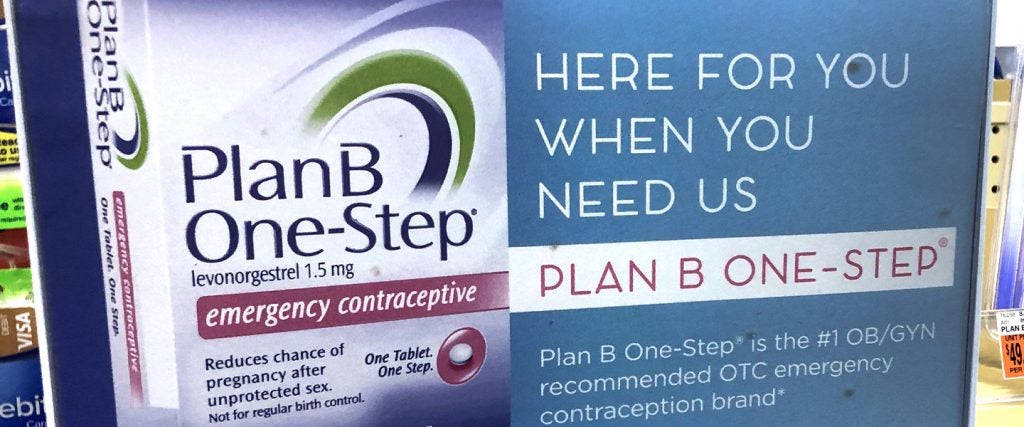Unsatisfied with the Supreme Court’s cruel overturning of Roe v. Wade — which has so far resulted in abortion bans in seven states, with more restrictions on the way — pro-forced birthers are now seemingly coming for contraception. While this shouldn’t come as a surprise — Justice Clarence Thomas has already said the court “should reconsider” the constitutional right to contraception and the Chrisitian right has long been opposed to safe sex — their methods are particularly manipulative. Or, er, just plain stupid.
Last week, anti-abortion group Students for Life shared what they thought was a “gotcha” video about Plan B, aka the morning after pill, aka emergency contraception. In the clip — which has been flagged on Instagram as containing false information — a forced birth advocate attempts to debunk Plan B’s claim that it doesn’t “harm an existing pregnancy.” Turning to the “fine print” on the box, she reads out how Plan B works: by preventing ovulation, the fertilization of a released egg or the attachment of a fertilized egg to the uterus. She then adds her own commentary: “Google that word. Google ‘fertilized egg,’ because it’s an embryo. Plan B is an abortifacient. Pass it on.”
Except, no, sweetie, it’s not. Let’s be clear: The morning after pill doesn’t cause abortions or miscarriages. It’s a form of emergency contraception that literally doesn’t work if you’re already pregnant (pregnancy doesn’t begin until implantation, when a fertilized egg has attached to the lining of the uterine wall — then it develops into an embryo). To put that in even simpler terms: Plan B prevents there from being anything to abort in the first place. This is something you can easily Google, or that would have been part of any good sex ed curriculum (though, to be fair, much of the country doesn’t have access to that).
Because of all this — and despite confusion in Missouri, where certain hospitals, pharmacies and urgent care clinics temporarily stopped providing Plan B because of the state’s new abortion ban — the morning after pill is still legal in every single state in America. Hell, it’s even sold over-the-counter in many states right there next to the condoms and yeast infection suppositories. If it were really a stellar abortifacient, do you think you could just walk into Walgreens and buy it?
To avoid further confusion during an already-confusing time, let’s take a deep breath and go over some basics on Plan B so we’re all on the same page.
What is Plan B?
Plan B is an emergency contraceptive pill that contains levonorgestrel, a synthetic progestin similar to the hormone progesterone. It works by preventing a woman’s egg from fully developing, and can also prevent the attachment of an egg to the wall of the uterus. Plan B can be purchased over-the-counter without a prescription, and should be taken within three days of unprotected sex (you can take it up to five days after, but the sooner you take it, the better it works). There’s some evidence that Plan B could be less effective in women who weigh over 165 pounds or have a BMI of more than 25, but, as a professor of obstetrics and gynecology recently told the New York Times, “the evidence is absolutely not crystal clear and consistent.”
There is another form of emergency contraception, called ella, which contains ulipristal acetate, that can be taken up to five days after unprotected sex (though it’s still best to take it as soon as possible) and is considered to be more effective than Plan B — particularly for women over 165 pounds. You need a prescription to get ella, but Planned Parenthood advises that you can “get a fast medical consultation and prescription with next-day delivery” via KwikMed.
Both cost around $40 to $50, but you may be able to get them for free via your health insurance.
How Is Plan B Different to an Abortion Pill?
The abortion pill is made up of two medicatons — mifepristone and misoprostol — which you take as two separate pills. The first stops the pregnancy from growing by blocking the hormone progesterone. The second — which you can take right away or up to 48 hours later — causes cramping and bleeding to empty the uterus, thus terminating the pregnancy. Planned Parenthood says it’s “kind of like having a really heavy, cramped period, and the process is very similar to an early miscarriage.”
Depending on where you’re living — and therefore what restrictions are in place — you can usually get abortion pills from a doctor, nurse or a health clinic. In some states, you can do a consultation online via telehealth and have the pills mailed to you. According to Planned Parenthood, the abortion pill could cost up to $750, but “it’s often less,” with the cost varying by state and/or health center. You may also be able to get it covered by your insurance. You can find out more information about accessing the abortion pill here.
So I Can’t Use Plan B as an Alternative to the Abortion Pill?
No! For the last time, Plan B will not stop you from being pregnant if you’re already pregnant. It can only prevent you from becoming pregnant. If you’re pregnant and you don’t want to be, you’ll need an abortion. If the state you live in has abortion bans or restrictions in place, you can travel to a state that allows it (though some states may criminalize that, too). The Guttmacher Institute has created a map that details each state’s current abortion policies. You can find it here. The map also shows you the driving distance from any state to the nearest abortion clinic, though again, in many states, you can still access abortion medication through telehealth or abortion services like AidAcess without an in-person visit.
Okay, So What You’re Saying is that Plan B Can Prevent abortion and It’s Silly to Take It Away?
Bingo.

